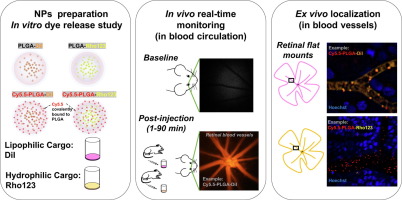European Journal of Pharmaceutics and Biopharmaceutics ( IF 4.9 ) Pub Date : 2020-03-06 , DOI: 10.1016/j.ejpb.2020.03.006 Enqi Zhang , Vasilisa Zhukova , Aleksey Semyonkin , Nadezhda Osipova , Yulia Malinovskaya , Olga Maksimenko , Valery Chernikov , Maxim Sokolov , Lisa Grigartzik , Bernhard A. Sabel , Svetlana Gelperina , Petra Henrich-Noack

|
PLGA (poly(lactic-co-glycolic acid))-based nanoparticles (NPs) are promising carrier-cargo systems because of their excellent biocompatibility and possibility of sustained drug release. However, it is not well understood how the kinetics of such drug delivery system perform in the retinal blood circulation as imaged in vivo and in real time. To answer this question, PLGA NPs were loaded either with lipophilic carbocyanine perchlorate (DiI) or hydrophilic Rhodamine 123 (Rho123) and coated with poloxamer 188 (P188): PLGA-DiI/P188 and PLGA-Rho123/P188. All particles had narrow size distributions around 130 nm, spherical shape and negative potential. Subsequently, we performed in vivo real-time imaging of retinal blood vessels, combined with ex vivo microscopy to monitor the kinetics and to detect location of those two fluorescent markers. We found that DiI signals were long lasting, detectable longer than 90 min in blood vessels after intravenous injection as visible by homogeneous labelling of the vessel wall as well as by spots in the lumen of blood vessels. In contrast, Rho123 signals mostly disappeared after 15 min post intravenous injection in such compartment. To explore how PLGA NP-loaded cargoes are released in vivo in the retina, we thereafter monitored the Cyanine5.5 amine (Cy5.5) covalently linked PLGA polymer (Cy5.5-PLGA) in parallel to DiI and Rho123.The Cy5.5 signal from PLGA polymer was detectable in the retina vessels longer than 90 min for both, the Cy5.5-PLGA-DiI/P188 and Cy5.5-PLGA-Rho123/P188 groups. Microscopy of the ex vivo retina tissue revealed partial level of colocalization of PLGA with DiI but no colocalization between PLGA and Rho123 at 2 h post injection. This indicates that at least a fraction of the lipophilic DiI was preserved within NPs, whereas no hydrophilic Rho123 was associated with NPs at that time point. In conclusion, the properties of PLGA carrier-cargo system in the blood circulation of the retina might be strongly influenced by the combination of factors, including the individual properties of loaded compounds and blood milieu. Thus, it is unlikely that a single nanoparticle formulation will be identified that is universally effective for the delivery of different compounds.
中文翻译:

视网膜血管中PLGA纳米粒子释放荧光染料的动力学:体内监测和离体定位
基于PLGA(聚(乳酸-乙醇酸共聚物))的纳米颗粒(NPs)由于其出色的生物相容性和持续药物释放的可能性而成为很有前途的载体系统。然而,如体内和实时成像的,这种药物递送系统的动力学如何在视网膜血液循环中表现尚不完全清楚。为了回答这个问题,在PLGA NP中装载了亲脂性的高氯碳酸花青素(DiI)或亲水的罗丹明123(Rho123),并用泊洛沙姆188(P188)涂覆:PLGA-DiI / P188和PLGA-Rho123 / P188。所有颗粒在130nm附近具有窄的尺寸分布,球形和负电势。随后,我们进行体内视网膜血管的实时成像,结合离体显微镜以监测动力学并检测这两个荧光标记的位置。我们发现,在静脉注射后,通过血管壁的均匀标记以及血管腔中的斑点可见,DiI信号在血管内持续很长,可检测到超过90分钟。相反,Rho123信号在此类隔室静脉注射后15分钟后大部分消失。为了探索PLGA NP负载的货物如何在体内在视网膜中释放,我们随后监测了与DiI和Rho123平行的Cyanine5.5胺(Cy5.5)共价连接的PLGA聚合物(Cy5.5-PLGA)。 Cy5.5-PLGA-DiI / P188和Cy5.5-PLGA-Rho123 / P188组的PLGA聚合物信号均在视网膜血管中检测到超过90分钟。显微镜检查体外视网膜组织显示,注射后2 h,PLGA与DiI的部分共定位水平,但PLGA和Rho123之间没有共定位。这表明至少一部分亲脂性DiI被保留在NP中,而在那个时间点没有亲水性Rho123与NP相关。总之,PLGA载体-货物系统在视网膜血液循环中的特性可能会受到多种因素的综合影响,包括负载化合物和血液环境的个体特性。因此,不可能鉴定出对于递送不同化合物普遍有效的单个纳米颗粒制剂。



























 京公网安备 11010802027423号
京公网安备 11010802027423号